Four of the cherry world’s leading designers of sweet cherry growing systems have come together to coauthor Cherry Training Systems, a comprehensive, step-by-step guide for growers.
The new, 63-page guide provides detailed, year-by-year instructions on training and pruning required for any of seven systems and advice on choosing rootstocks and spacings for them. The systems are: Kym Green Bush (KGB), Spanish bush, steep leader, super slender axe, tall spindle axe, Upright Fruiting Offshoots (UFO), and Vogel central leader. (Read a synopsis of these systems)
This Pacific Northwest Extension publication (PNW 667) was produced cooperatively by Oregon State University, Washington State University, and the University of Idaho in cooperation with Michigan State University.
The four authors are prominent university figures familiar to most cherry growers from winter horticulture meetings and field days where they, often with pruning shears in hand, have shown growers what cherry orchards will look like in the different training systems and why they might choose any one of them.
In this publication, they lay it out in detail, with color pictures of mature trees and lots of easy-to-understand diagrams showing how to get there.
The writers are:
—Lynn Long, Oregon State University Extension horticulturist in Wasco County, Oregon, who has investigated the performance of five of the training systems in Oregon;
—Stefano Musacchi, research horticulturist at Washington State University who began his research while at the University of Bologna in Italy and developed the slender spindle axe system;
—Matthew Whiting, horticulturist at Washington State University, who developed the Upright Fruiting Offshoot system from work that began when he was a graduate student mentored by Greg Lang at Washington State University;
—Greg Lang, now a professor of horticulture at Michigan State University, a leader in explaining cherry tree physiology, the tree’s response to pruning and training, and a key figure in the NC-140 project, which since 2010 has investigated the performance of four of the training systems in cherry growing regions across the United States and Canada.
“This guide has essentially been 10 years in the making, greatly expanding upon Lynn Long’s excellent previous guide by incorporating many new training system concepts and strategies from around the world that are innovative, productive, and labor efficient,” Lang told Good Fruit Grower.
“In my international travels, growers everywhere have asked for a step-by-step guide that can help them understand the rationale behind different canopy training systems and how to match them to rootstocks of varying vigor and precocity as well as local growing conditions.
“We have really been quite fortunate to compile such a guide that directly draws upon not only the international expertise of scientists such as Matthew Whiting, Stefano Musacchi, Lynn Long, and myself, but also on our many collaborative experiences with progressive and creative cherry growers, consultants, and nurserymen around the world.”
Long said he wrote the first cherry training system manual in 2002. “But it has become obvious in recent years that there was a critical need for a new manual that expanded the number of systems featured. Scientists such as Drs. Greg Lang, Matt Whiting and Stefano Musacchi have developed some outstanding science-based systems in the last few years that increase precocity, allowing for high yields of premium quality fruit while easing labor needs.
“These new systems are being planted all over the world, yet, until this guide came out, there was no definite source of information where growers could obtain accurate instructions on how to properly train these trees.”
The natural tree
Undisturbed in its native environment, the young sweet cherry will grow as a central leader tree, the authors explain in the guide’s introduction. Growth is rapid and apical dominance is strong. Thus, the tree tends to branch only just below the terminal bud of annual growth, can grow to 60 feet, and is non-precocious so it can establish a competitive “footprint” in the forest before shifting resources to fruiting.
All growers face the challenge of managing sweet cherry so that the tree remains small, generates branches at the desired locations, and begins producing fruit by the second or third leaf, they write.
It is vitally important that trees produce an abundance of new shoots about two feet long every year because the largest and best quality cherries are produced at the base of the previous year’s growth and on young spurs.
The guide’s authors steer growers toward the best rootstock size for the system they choose.
There are several to choose from. Mazzard, Mahaleb, and Colt are vigorous. Gisela 6 and 12, Krymsk 5, MaxMa 14, and CAB6P are semi-vigorous. Gisela 5 and Krymsk 6 are semi-dwarfing. Gisela 3 is dwarfing.







Leave A Comment